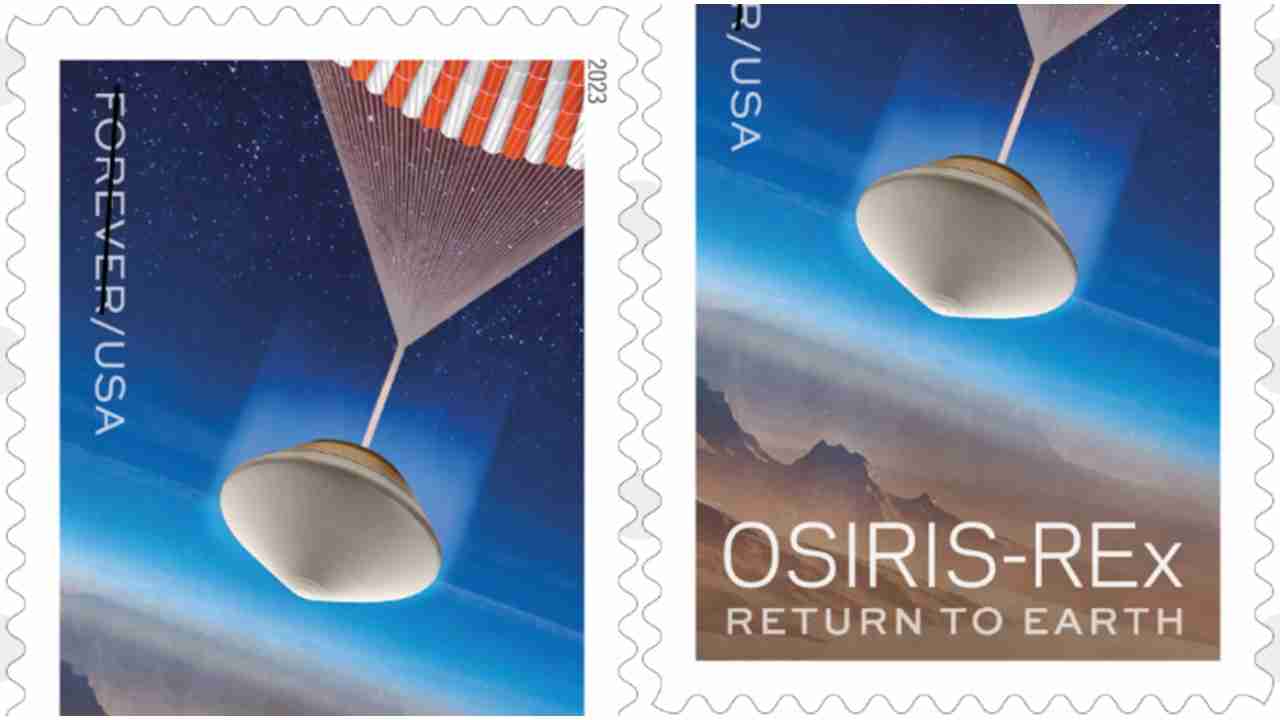The Postal Service also announced an additional stamp to its 2023 stamp program honoring NASA’s OSIRIS-REx mission to deliver asteroid samples to Earth. OSIRIS-REx — a collaboration between NASA, the University of Arizona, and Lockheed Martin — exemplifies American ingenuity, perseverance, and teamwork. Details of the issue date and location are forthcoming.
With this new stamp, the U.S. Postal Service celebrates NASA’s seven-year OSIRIS-REx mission to study and map the asteroid Bennu and deliver a sample of the surface to Earth in September 2023. The sample will help scientists learn how the solar system formed.
OSIRIS-REx is an acronym for the mission’s goals: Origins, Spectral Interpretation, Resource Identification, and Security–Regolith Explorer. More simply, “Origins” refers to the study of the pristine carbon-rich material the spacecraft collected. “Spectral Interpretation” means measuring the composition of the asteroid. “Resource Identification” is assessing potential fuel, oxygen, water, and minerals on the asteroid. “Security” relates to scientists’ calculating the odds that Bennu might collide with Earth. The final part of the mission’s name, REx, is short for “Regolith Explorer,” and it refers to studying the regolith—or layer of loose material on the asteroid’s surface.
The OSIRIS-REx spacecraft, which is the size of a large passenger van, left Earth aboard a rocket launched from Cape Canaveral, Florida, on September 8, 2016. Once released from the rocket, it orbited the Sun for a year until it passed by Earth again. At that point, our planet’s gravity helped propel the spacecraft toward Bennu, which also orbits the Sun but at a different angle than Earth. Our planet and the asteroid come closest to each other every six years. After OSIRIS-REx arrived in the asteroid’s orbit, in December 2018, it got to work. With its special cameras and spectrometers, it began photographing and mapping Bennu’s surface to determine the best site from which to collect samples. Scientists were surprised to learn, from the photographs the spacecraft sent back, that the asteroid’s surface was much different from what they had expected. Instead of being relatively smooth, it was rocky and cratered, so finding a sample-collection site posed challenges. Eventually they chose a site about the size of a tennis court, located in a crater.
The time for the rendezvous arrived in October 2020. To carry out its task, the spacecraft did not actually land on the asteroid but instead slowly descended toward the surface and extended a robotic arm. A collection device at the hand-end of the arm then released a sudden puff of nitrogen gas that sent up a cloud of dust and rocks from Bennu’s surface. More than two ounces of these materials were captured in a special container in the collection device, which then closed and retracted into the spacecraft. Even though this seems like a miniscule amount considering the effort involved, it’s the largest sample ever collected from an asteroid, and the first asteroid sample by the United States.
On May 10, 2021, OSIRIS-REx began its flight back toward Earth. Its container of asteroid dust and rocks, enclosed in a special capsule, is expected to parachute down to the Utah desert on Sept. 24, 2023.
The OSIRIS-REx pane of 20 stamps will be issued as Forever stamps. Forever stamps will always be equal in value to the current First-Class Mail 1 ounce price. News of the OSIRIS-REx stamp is being shared with the hashtag #OsirisRexStamp.

